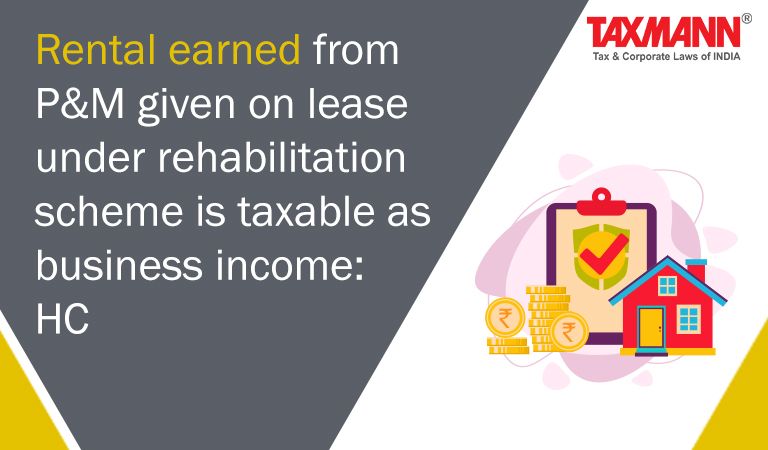Rental earned from P&M given on lease under rehabilitation scheme is taxable as business income: HC
- Blog|News|Income Tax|
- 2 Min Read
- By Taxmann
- |
- Last Updated on 13 February, 2022
Case Details: CIT v. Premier Tyres Ltd. - [2021] 133 taxmann.com 432 (Kerala)
Judiciary and Counsel Details
-
- S.V. Bhatti and Bechu Kurian Thomas, JJ.
- P.K.R. Menon, Sr. Counsel and Jose Joseph, SC for the Appellant.
- K.P. Abdul Azees, V. Abraham Markos, Binu Mathew, Advs., Joseph Markose, Sr. Adv., B.J. John Prakash, Mathews K. Uthuppachan, Terry V. James and Tom Thomas Kakkuzhiyil, Advs. for the Respondent.
Facts of the Case
Assessee was a company engaged in the manufacture and sale of tyres. The assessee had a business loss over the paid-up capital. Thus, it presented a case for the revival and rehabilitation of its business before the Board for Industrial and Financial Reconstruction (BIFR). BIFR approved/sanctioned arrangement between assessee and Apollo Tyres Ltd. (ATL) and plant and machinery (P&M) were given on lease by the assessee to ATL for eight years.
The assessee filed a return of income and treated income received from ATL as income from the business. However, the Assessing Officer (AO) treated said receipt as income from other sources. On appeal, the CIT(A) upheld the order of AO. Later, the Tribunal reversed the order of AO, and revenue filed an instant appeal before the High Court.
High Court Held
The Kerala HC held that the assessee under the approved rehabilitation scheme was obligated to exploit business assets, earn income, adjust/set off accumulated losses/unadjusted depreciation and turn into a positive company.
Under the approved rehabilitation scheme, the assessee was obligated to work and lease out Plant, Machinery etc., to ATL for manufacturing tyres that were in the same business. Further, the workforce of the assessee had been deployed for manufacturing tyres, and ATL took over the total production from the assessee unit. Thus, it can be concluded that the assessee employed commercial assets to earn income.
The rehabilitation scheme is appreciated as one providing a solution to the business problem of the assessee. Thus, unless and until income was treated as business income, the scheme could not result on expected lines as losses, unavailed depreciation, etc., would continue to be present in the assessee’s accounts.
Accordingly, the assessee’s claim of lease rental receipt as income of business was justifiable.
Case Review
-
- Premier Tyres Ltd. v. Asstt. CIT [2005] 3 SOT 556 (Cochin.) (para 17) affirmed.
List of Cases Referred to
-
- Universal Plast Ltd. v. CIT [1999] 103 Taxman 493/237 ITR 454 (SC) (para 9)
- Commissioner of Excess Profits Tax v. Shri Lakshmi Silk Mills Ltd. [1951] 20 ITR 451 (SC) (para 10)
- CIT v. Vikram Cotton Mills Ltd. [1988] 36 Taxman 1/169 ITR 597 (SC) (para 10)
- Rayala Corporation (P.) Ltd. v. Asstt. CIT [2016] 72 taxmann.com 149/243 taxman 360/386 ITR 500 (SC) (para 10)
- Chennai Properties & Investments Ltd. v. CIT [2015] 56 taxmann.com 456/231 taxman 336/373 ITR 673 (SC) (para 10)
- CIT v. Oberon Edifices & Estates (P.) Ltd. [2019] 103 taxmann.com 413/263 Taxman 377 (Ker.) (para 10)
- CIT v. Mysore Wine Products Ltd. [2014] 49 taxmann.com 332/226 Taxman 132 (Mag.)/[2015] 370 ITR 102 (Kar.) (para 10).
Disclaimer: The content/information published on the website is only for general information of the user and shall not be construed as legal advice. While the Taxmann has exercised reasonable efforts to ensure the veracity of information/content published, Taxmann shall be under no liability in any manner whatsoever for incorrect information, if any.

Taxmann Publications has a dedicated in-house Research & Editorial Team. This team consists of a team of Chartered Accountants, Company Secretaries, and Lawyers. This team works under the guidance and supervision of editor-in-chief Mr Rakesh Bhargava.
The Research and Editorial Team is responsible for developing reliable and accurate content for the readers. The team follows the six-sigma approach to achieve the benchmark of zero error in its publications and research platforms. The team ensures that the following publication guidelines are thoroughly followed while developing the content:
- The statutory material is obtained only from the authorized and reliable sources
- All the latest developments in the judicial and legislative fields are covered
- Prepare the analytical write-ups on current, controversial, and important issues to help the readers to understand the concept and its implications
- Every content published by Taxmann is complete, accurate and lucid
- All evidence-based statements are supported with proper reference to Section, Circular No., Notification No. or citations
- The golden rules of grammar, style and consistency are thoroughly followed
- Font and size that’s easy to read and remain consistent across all imprint and digital publications are applied








 CA | CS | CMA
CA | CS | CMA


